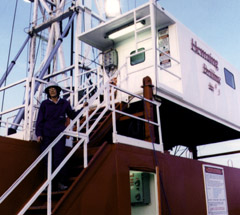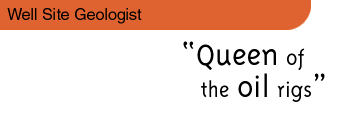
Heather Callaghan's job has her providing some pretty vital information
to oil companies. "I'm their eyes and ears," says the Petroleum Technologist/Well
Site Geologist, who works for one of the largest geological consulting
firms in the world. The firm assigns her to oil rigs, where she analyzes
the rock being drilled and assesses the zone's potential for oil and gas
production. |
 |
 |
 |
Heather looks at samples that have been collected from the drilling
mud. What looks just like muck to the naked eye can, with a microscope
and a fluorescent light, tell her the properties of the rock below
and the type of fluid it contains. Studying a core - a cylinder
about twice the length of a flag pole - can give her more clues,
such as how much oil can be found. The pores and cracks in its rock,
which make good reservoirs for oil, are the litmus test for a well-site's
production potential. The speed of the drill will also shed clues
about the volume of oil. The faster the speed, the more porous the
rocks. |
 |
| |
|
|


